Foraging wild violets is a fun project for all ages. Fortunately, wild violet is easy to identify and use! This beautiful and abundant little plant, both edible and medicinal, is one that’s put to good use every spring.
This post may contain affiliate links at no additional cost to you. By making your purchases through the links on this website, IMSL may make a small percentage at no direct cost to you. IMSL only promotes products we use & truly believe in. Please refer to my Privacy & Disclosures for further information. IMSL thanks you for your support!
Wild violets, one of the first flowers to appear every spring along with the beloved dandelion, is a welcome sight after the long winter months.
Fortunately, the wild violet readily self-sows (much to the chagrin of many lawn connoisseurs), and needs no care to ensure its appearance every year.
Although many consider it an invasive “weed”, this dainty flower is actually edible and medicinal. That and the pollinators love it as well 🐝
IDENTIFYING WILD VIOLETS
Wild violet is easy to identify, making it a wonderful first for foraging beginners.
A member of the Viola genus, the most common variety of wild violets consists of Viola odorata and Viola sororia for foraging here in the Northeast.
Sharing Is Caring ❤️
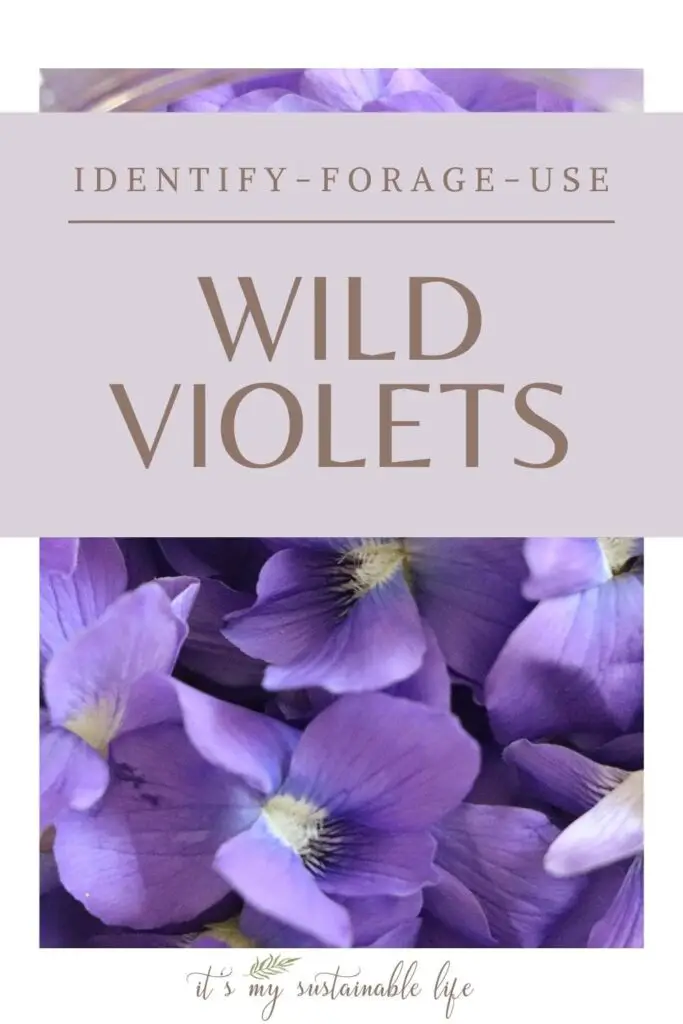
This deer resistant plant will grow to an average height of 4 to 6 inches, typically in a rounded, mound like formation.
Used as both food and medicine, more on each below, this perennial wildflower is native to North America from the Rocky Mountains to the East and are often referred as “common blue violets”. This plant should not be confused, however, with the African violet, a common houseplant which is not edible or medicinal.
When identifying wild violets consider its four main parts in addition to its growth habit. The leaf, the flower, the stem, and the rhizomes.
GROWTH HABIT
Wild violets are a low growing, herbaceous plant that grows well in both sunny locations as well as partial shaded areas.
As you can see in the video below, I have these little beauties popping up all over my backyard area which receives full, blazingly hot sun.
Although tolerant of a multitude of soil conditions, they prefer moist and well-draining rich soil, but will tolerate drought-like conditions.
The root system is dense with fibrous roots that grow horizontally. Due to its spreading root system, eradicating wild violet is a difficult if not impossible task.
It’s the incredible root system which includes rhizomes, more on the rhizomes below, which aid this native plant to spread prolifically.
Wild violets are abundant largely because of their numerous self-seeding abilities. Unlike many other native flowers, wild violet initial flowers create no seeds.
Instead, the plant creates a flower near the soil level that never opens. These unopened flowers are called “cleistogamous” or non-opening, self-pollinating, flowers.
It’s these “flower” seed pods which produce tiny black seeds. This plant can self sow via its rhizomes as well as with these tiny seeds.
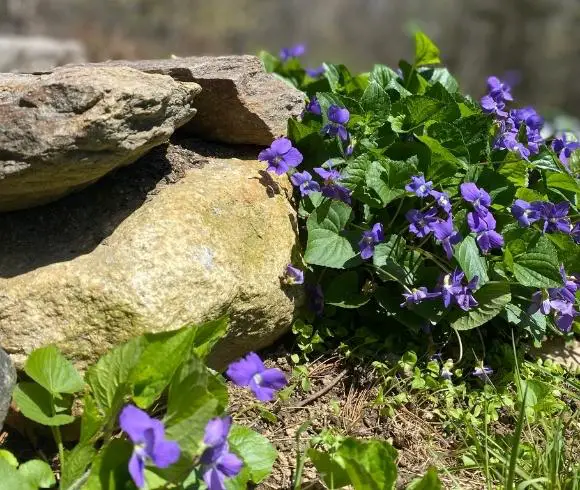
WILD VIOLET FLOWERS
Blue may be the most commonly found wild violet, but they do appear every now and then in different colors including yellow (usually the first to flower & is the rarest to find), white, and even multicolored blossoms.
The flowers appear in early spring and in some more temperate locales will show themselves as early as mid-February and March.
Here in the Northeast we can expect them to begin blooming right alongside dandelions and lilacs, both of which are not only edible but medicinal as well. This is typically right around early to mid-May weather dependent.
These small, dainty flowers are easily identified. Very similar to pansies in appearance, the flower itself will have 5 petals.
These 5 petals grow in a star-like shape, the main point always pointing in a downward direction. The blooms are 5 petals with a pair of petals on the top, one petal on each side and one petal pointing downward, kind of like a dog with his tongue hanging out 😂
The center of the flower is typically lined with streaks of a contrasting shade.
THE STEM OR STALK
Each individual flower grows from a leafless single stem or stalk typically growing from the base center of the plant.
THE LEAVES
Violet’s leafing system is very tell-tale when identifying the plant. The distinguishable heart-shaped leaves are the tell.
The leaves, some short, some fat, some longer, some shorter, some a bit more round are essentially the same. They form a heart.
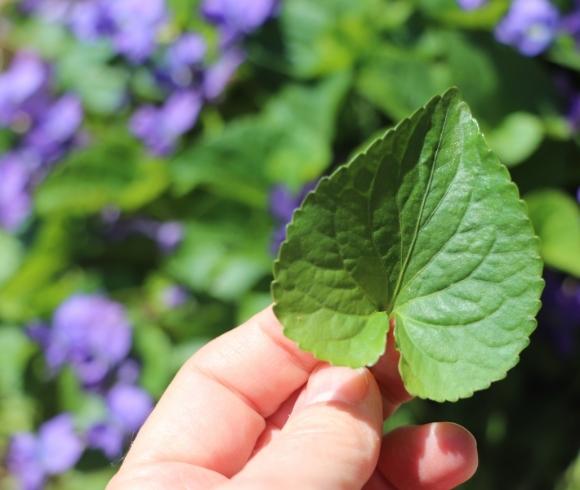
Serrated edges which are saw-toothed sharply at the top of the heart and seem to smooth their edges toward the point of the heart.
The leaves are smooth and hairless for the most part, and are dark, verdant green in color which seem to grow larger when located in shaded areas.
The lobes or top rounded curves of the heart shape are often curled toward the stalk itself.
The underside of each leaf shows prominent veining.
It’s best to harvest the leaves when there is still a bit of curling remaining.
Again, due to the leaf’s similarities to the Lesser Celandine plant which is toxic to ingest, it’s best to wait until the plant flowers before consuming or using the leaf.
THE RHIZOMES
Wild violets are so drought tolerant due to their rhizomes. Rhizomes are short, thick, clumpy portions of the underground stem system.
These rhizomes are what store water so efficiently enabling the plant to withstand drought conditions.

Violet rhizomes are pretty intelligent. When the plant is picked or pulled from above they develop new shoots and create new plants.
HOW TO HARVEST WILD VIOLETS
As with any wild foraging and harvesting excursion, understanding that wild violet offers an early nectar source for native pollinators along with the dandelion will remind us to harvest sustainably.
Taking more than you need will leave little for these essential insects. Never take more than half the blooms and always leave more than you take.
When harvesting the leaves realize that taking too much from the plant can harm the plant itself as well. Taking too many greatly reduces the plants ability to photosynthesize, thus inhibiting the plants ability to create food for its continued health & growth. Plan on taking no more than 25% of the leaves from any one plant.
Depending on what your intent is to use your foraged wild violet for will determine what and when to harvest.
Both the flowers and the leaves are edible, but should your intent be to harvest the plant for its healing properties, go for the leaves.
HARVESTING WILD VIOLET FLOWERS
The flowers make a wonderful and dare I say beautiful and nutritional addition raw to any mixed green salad. It’s said that it offers the highest vit C content than any other plant, and is rich in minerals like calcium & magnesium.
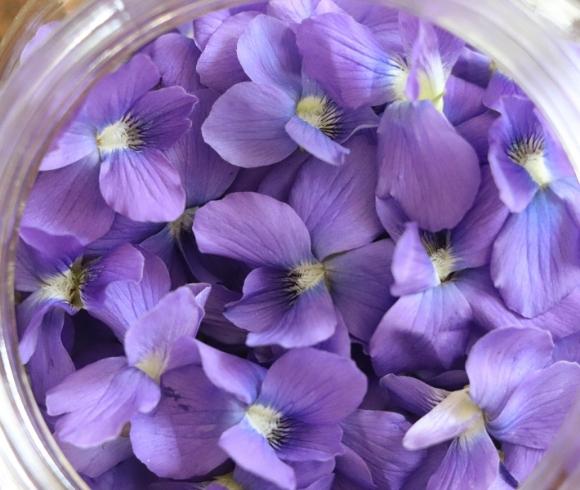
Although not extremely flavorful, the flowers still offer a slightly floral & peppery flavor to fresh dishes.
Frozen in ice cubes, the delicate flowers make for a decorative touch to any drink.
But that’s not all you can add & use the flowers with. Here are a few ideas from friends around the web …
- Make a flavored syrup
- Add to homemade ice cream
- Make wild violet sugar
- Wild violet jelly
- Wild violet vinegar
To harvest the flowers, do so in the morning once the dew has dried. Using a pair of sharp scissors or gardening/foraging snips simply snip the flower from the stem at the base of the flower.
HOW TO DRY VIOLET FLOWERS
Although there are many methods for drying and preserving fresh herbs and flowers, one of my favorite ways to dry flowers and herbs is via air drying.
Air drying not only uses no energy and therefore is a more eco-friendly way to dry fresh flowers, but it also maintains the flower’s shape more readily.
To air dry your violet flowers simply lay them out on a drying screen or a cooling rack. Something that will allow airflow around the entire blossom. Place the tray or rack in a well ventilated area out of direct sunlight and allow to completely dry. This will typically take about 4 to 7 days depending on the humidity in your area.
HOW TO STORE DRIED VIOLET FLOWERS
Store dried violets in an air-tight container for up to one year. Place the jar in a dark cupboard or apothecary cabinet.
HARVESTING WILD VIOLET LEAVES
When looking to utilize the leaves of the wild violet, I like to gather and dry them during the early spring months. Although you can enjoy the leaf throughout its growing season, I prefer the tender early growing leaves with a bit of curl left in them.
Gather the leaves in the morning once the dew has dried. Using a pair of sharp garden snips or scissors, snip the tender leaves from the stems. I like to leave about a couple of inches of stem on the leaf to use as well.
Remember, to sustainably forage the leaves, take no more than about 25% of the plant and allow the rest to grow.
HOW TO DRY WILD VIOLET LEAVES
Again, air-drying is my preferred method for drying my herbs and foraged items.
To dry the violet leaves I make bundles. Gather 10-15 stems and secure them with either a rubber band or tie with twine.
Hang them upside down as I do with my basil and allow to dry completely. Depending on your humidity levels, this can take a week or longer.
HOW TO STORE DRIED VIOLET LEAVES
To store your dried violet leaves, crunch them up in your hand, and place them into an air-tight container.
Store your preserved leaves in a cool, dark cupboard for use throughout the year.
BENEFITS OF WILD VIOLET LEAVES
When looking to utilize this plant for its medicinal properties, use the leaves.
Not only high in vit C and vit A, the leaves are also known for their mucilaginous content (think a watered down texture similar to chia seed that have been soaked). The mucilage makes them unappetizing for some (I don’t take issue with it) but it’s this same property that makes the leaves efficacious for digestive issues, sore throats and seasonal coughs.
Mucilage in the kitchen can be put to work thickening soups and sauces with an added nutritional boost.
Containing a phytochemical, rutin, allows this plant to work as an anti-inflammatory and antioxidant which aids in neutralizing free radicals. Chronic disease prevention anyone?
In addition the leaves assist …
- Headaches – the salicylic acid found in both the leaves and flower are similar to the pain-relieving component found in aspirin
- Skin Issues – the salicylic acid and anti-inflammatory properties of this plant help clear skin abrasions, inflamed skin & sores (poultice), hemorrhoids, eczema, dry skin (balms & salves), and varicose veins
- Sleep – Utilizing the upper portion of the plant as an infusion helps promote sleep
- Infections – working as a gentle immune stimulant, this plant can assist in clearing infections such as upper respiratory, congestion, and bronchitis when taken as a strong infusion (think expectorant here)
- Lymphatic System – wild violet works toward promoting a healthy lymphatic system within the body. Interestingly, an infused oil utilizing the leaf can be used as a breast massage to promote overall breast health
Capturing the benefits of wild violet leaves is as easy as gathering them and utilizing them in the making of infusions, tea’s, tinctures, salves & balms, soaps, and syrups!
And don’t forget to eat them fresh while in season!
SOURCING WILD VIOLET
Should you be in an area without access to this wonderful little plant, dried violet leaf is available from one of my favorite herbal sources. Mountain Rose Herbs.
Using this link supports not only an amazing company, but also this site at no additional cost to you. And I thank you for it 🙏🏻
WILD VIOLET FUN FACTS
The violet plant is known by many names. Wood violet, sweet violet, English violet, garden violet, common violet, and florist’s violet are all notable ones.
Sweet violet is said to be the fairest of them all, well when it comes to fragrance that is 😊
The Greeks symbol of fertility & love is the violet. So much so that the violet was used in creating love potions.
It was also used by the Greeks to create garlands worn to stave headaches and dizziness. In addition, they would use the plant to aid sleep issues, strengthen the heart, and calm anger.
In the Victorian era until the First World war, violet was used in candy making and baked goods due to its unique flavor. Used not only for its floral flavoring, but also as a decorative addition as they were pressed into the tops of cookies and crystalized with sugar to decorate cake tops.
A liqueur made from infusing violets into spirits known as “Creme de Violette” is floral and delicate in taste and is now being reintroduced.
There are between 400 to 500 species of the violet plant found throughout the world! Although most are found in the Northern Hemisphere, they can be found in Hawaii, the Andes, and Australasia (consisting of New Zealand, Australia & a few neighboring islands).
Violets are the state of Illinois flower of choice, the state voting to make this their state flower in 1907.
The violet flower has both stamens (male) and pistil (female) reproductive organs.
Wild violet is not only a beautiful addition to any landscape, but a nutritious and beneficial one to anyone utilizing its amazing properties.
Now that you know how to identify, forage, and use wild violet, what will you be making first?
Love, Light, & Laughter ~

SHOP THIS POST
Enjoy this article? Please consider sharing it on your favorite social media channel! Want more? Subscribe below for the occasional update with all the “happenings on the hill”!

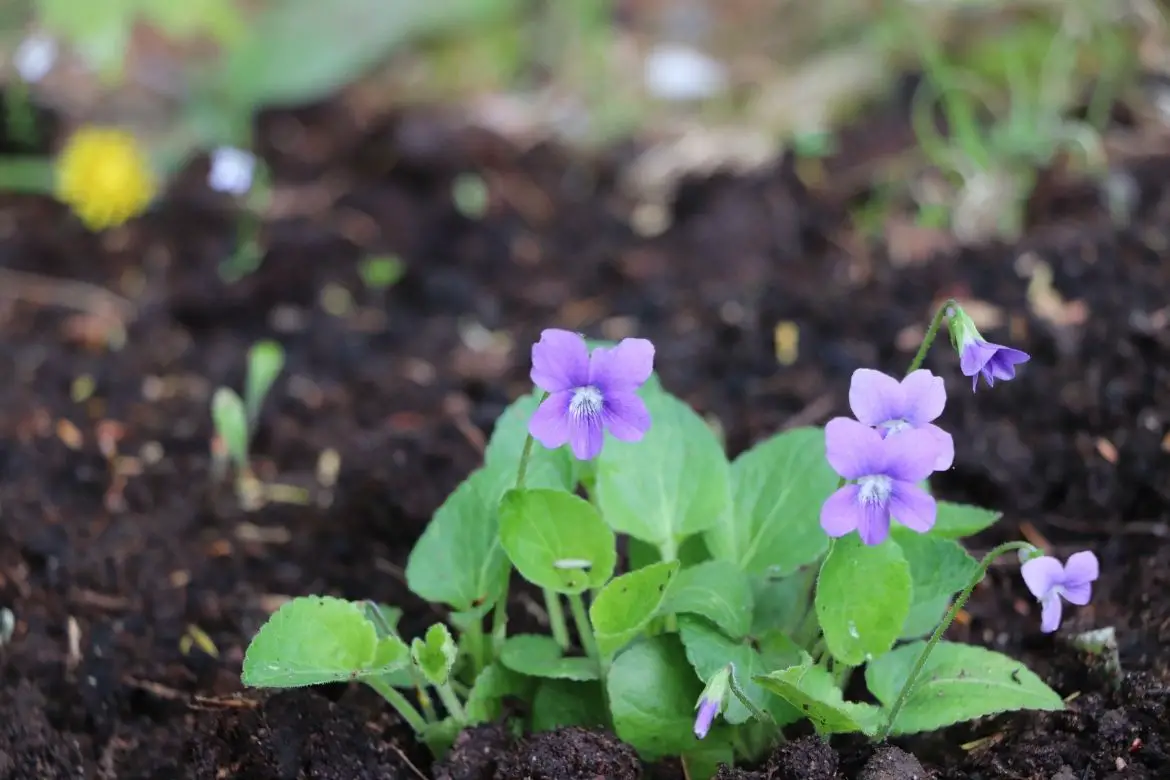

15 comments
Wild violets are pretty. We had no idea the uses for them. Thank you for sharing.
I enjoy foraging. But I don’t have to go far to collect wild violets! They grow all over my backyard. I make wild violet tea.
I had no idea that violets had medicinal properties! This was so interesting to learn about.
I love wild violets. They are so pretty and remind me of my childhood and the promise of summer. Loved learning all these fun facts and how to forage them.
I loved learning that the wild violet has medicinal properties. It’s so cool to learn about the different edible wild plants.
This is so lovely! I didn’t realize that I had wild violets growing in my backyard! We were doing “no mow May” to help pollinators find their pollen & it really allowed us to see what little flowers grow back there. I’m definitely going to try to forage some wild violets now. Thanks for your wonderful tips!
My yard is full of wild violets, I never thought of picking them. I’m going to grab some and add them to ice cubes, what a lovely idea.
I will definitely look to forage wild violets on my next hike. You explain the process of drying and using them so easily that anyone can do this. Thanks.
I have a very special fondness for violets and do grow them at my house! My God-Mother who passed grew violets and I’ve planted hers at my house to remember.
Making ice cream out of wild violets sounds really interesting. Maybe even sugar cookies! Thanks for an interesting read, definitely learned a few new things!
That is pretty cool that the wild violet leaves can be harvested and used for healing! It is a pretty weed that is useful!
Yes, this herb is one that is both beautiful & efficacious!
They look so pretty that I’m surprised anyone would call them a weed! I’m glad you clarified between this and the African violet, because I was totally thinking African Violet in my head until you mentioned it!
There are so many things I didn’t know about violets! I didn’t know they could be different colors, and I didn’t know they could be used for so many health purposes. I just thought they were pretty! I kind of want to add them to ice cubes now to be used in lemonade or a punch. Cool ideas!
I love all your tips for foraging wild violets. I never knew I could save them for a year to use for headaches and to help me sleep. Great advice, as always. The video was especially helpful.